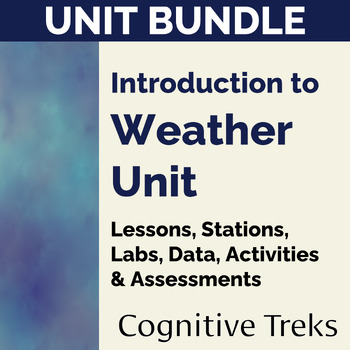Introduction to Weather Unit Bundle | Meteorology | Science Lessons & Activities
- Zip

Products in this Bundle (15)
showing 1-5 of 15 products
Bonus
Description
Introduction to Weather Unit Bundle is a complete and comprehensive group of lessons, stations, labs, data, activities and assessments for your class! Learn about weather patterns, conditions & forecasting through real world examples! Enjoy videos, diagrams, interactive weather maps & hands-on model activities to reinforce key concepts. Students will love the "Movement of Air" and "Movement of Water" lessons exploring the weather cycles on Earth. Find out about weather forecasting tools, air masses, maps and predictions. The will be "thunderstruck" by the unique "Discovering Phenomena - Lightning Strikes" data lesson. Unit includes two great assessments (keys included) and a one pager assessment. Ease your prep by getting this entire unit & enjoy!
What’s included (table of contents):
Pre-Unit Start: Anticipation Guide
1: Heat on Earth
2: Movement of Air
3: Under Pressure
4: Air Man! - CER Investigation
5: Heat and Air Assessment
6: Movement of Water
7: Weather vs. Climate
8: Weather Forecasting 1 - Tools
9: Capture the Wind (Anemometer Lab)
10: Weather Forecasting 2 - Air Masses and Fronts
11: Weather Forecasting 3 - Understanding Maps
12: The Power of Storms
13: Discovering Phenomena - Lightning Strikes
14: Weather Assessment
Additional Resources to Assist:
Projects / STEM / PBL Resources
Extra Information for You:
Click here to follow my store to receive notifications of new products and upcoming sales.
Click here to check out my website! Cognitive Treks is a place to learn about educational travel; combining science education and lessons with real world experiences.
Your business is greatly appreciated!
Copyright © Cognitive Treks. All rights reserved by author.





